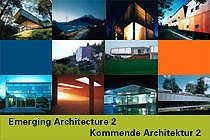
|
Emerging Architecture 2 - Kommende Architektur 2 10 More Austrians Location: Architekturzentrum Wien - Old hall Exhibition: 06 December 2001 - 15 April 2002 Opening Hours: Daily 10:00 am - 7:00 pm Opening: Wednesday 5 December 2001, 7pm cukrowicz.nachbaur fasch&fuchs. Maria Flöckner and Hermann Schnöll Hans Gangoly gerner°gerner plus Erich Gutmorgeth HOLODECK.at MARTERERMOOSMANN Gerhard Mitterberger Wolfgang Tschapeller This year’s selection shows a number of emphases: minimized assembly work, new approaches to recreational facilities in Alpine landscapes, novel concepts for residential structures, transformations of historical architectural substance, shifts of horizons between architecture and nature. The ten offices presented in this volume are joined by one common tendency: a distance kept from sculptural, massiveconstructions and a leaning toward bodiless, skeletal and membranous spatial definitions. Altogether, these architectures are by no means attached to ’strong images’, but rather powerful sensual aggregates serving qualities that leave behind what can be illustrated: architecture is not somethingthat fills up space in a more or less spectacular fashion - it is what conditions space in the first place. Here, the reality of architecture consists in what sets buildings in action within the flow of life, much more so than photogenic constructions. In this connection, one question emerges with respect to international trends: What’s new about these constructions? ’Emerging Architecture’ is not intended as a show window for absolutely set originality, nor is this framework to discover or propagate tomorrow’s styles. Rather, the yardstick applied to these explorations is to make visible the extent, in concrete contexts, to which younger-generation architects are able to translate concepts and ideas into reality and thus decisively stimulate the quality of future endeavors. Three fourths of the buildings and projects in this volume are located outside of Vienna and concern interventions into rural, Alpine,small-town and quite traditional environments - where they altogether appear as novel and perhaps as futuristic as Guggenheim in Bilbao, yet with one difference: they refrain precisely from embodying implants of cultural imperialism. Every one of them was created from local requirements and mostly via public competitions, and elaborated and struggled for in dialogues discussing any local political, technical and bureaucratic factor. The novelty value and progress made for those truly involved and concerned is, in my mind, more sustainable and extensive than what critique solely concentrated on theoretical discourse may possibly wish to perceive. |
 |
|
|
|
Current Preview Permanent Exhibition Emerging Architecture 2 - Kommende Architektur 2 Press Release 10 More Austrians * cukrowicz.nachbaur * fasch&fuchs. * Flöckner Schnöll Architects * Hans Gangoly * gerner°gerner plus * Erich Gutmorgeth * HOLODECK.at * MARTERERMOOSMANN * Gerhard Mitterberger * Wolfgang Tschapeller E-Shop Products: Book: Emerging Architecture 2 / Kommende Architektur 2 DVD: Emerging Architecture 2 - Kommende Architektur 2 Information: Ines Purtauf Tel.: +43 (1) 522 31 15 - 25 Fax: +43 (1) 522 31 17 Email: purtauf@azw.at |
| © Architekturzentrum Wien 2025 |
||



